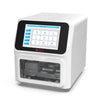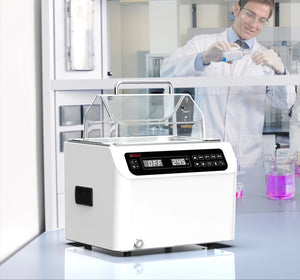How a “simple” device became a laboratory mainstay
Many mechanical novelties have their heyday and then go the way of the dinosaur. The pogo-stick, that fat burner shaking-thing used in every classic cartoon, and even fax machines are now on their way out. But one device has outlasted them all and has even thrived. That device is the vortex mixer. They are found on most laboratory benches mixing everything from lifesaving drug substances to coliform saturated wastewater. The utility of the device has kept it in the laboratory equipment mix longer than the nephelometer and its use will probably outlast some Real Time PCR devices. But HOW did it get started, WHY did it catch on, and WHAT’s next for the simple mixing device?
The HOW – An Apparatus for Mixing Fluent Material
Right around the time IBM was launching its first commercial computer, which weighed over a ton and had less memory than a tradeshow giveaway USB drive, a patent was filed by Jack and Harold Kraft of Flushing, NY. The patent was filed on behalf of their company, Kraft Scientific Corporation, in April of 1956. This patent would forever change the way scientists work. Patent Images (uspto.gov)
Much like Control+Alt+Delete permeates the computer world, the vortex mixer’s simplicity satiates all scientists need for miscibility. Jack and Harold were masters at designing, patenting, and manufacturing laboratory mixing equipment. Maybe it was the stickball injury that Jack received as a child that helped him innovate so many devices, because the designs that him and his brother came up with were second to none. Jack Kraft Biography on Flickr
Kraft Apparatus, Inc ceased operations in 1983 but Glas-col, the company that purchased, them is still going strong today in the laboratory equipment space. Kraft Apparatus, Inc. Company Details)
Some of these amazing decades old devices cobranded by Kraft and Glas-col can be found on auction websites around the world.
Kraft Apparatus Inc (Glas-Col Apparatus) Rugged Rotator Model RD-250 -- working – TZSupplies.com
The WHY – Some products are just too good
Why the vortex mixer caught on is simple. It was a great design that solved many problems. Mixing small containers in the lab was done by shaking or flicking, and both methods were not ideal to create the perfect suspension. Manual mixing took a long time, it was laborious, it didn’t work that well, and it could result in dangerous spills. Jack and Harold’s vortex mixing device solved many problems:
- It was quick
- It was easy to use
- It was safe
- It was inexpensive
- It was small
- It was low power
The device was so useful because the design was very good. This was stated succinctly in the 1956 patent as such, ”a table top type fluent material mixer that requires a minimum amount of space, power and specialized skill for its proper operation.”
There are 3 main design features in the patent that make the device so important.
- An off-center cup attached to an electric motor – This allows for rapid oscillation of the small container to ensure quick vortexing of the liquid
- The “Cup” itself – allows for the perfect area to rest a test tube without slipping
- The Dynamic Bearing and Retention Assembly – This allows for the cup to oscillate but not to spin, which would rotate the container and not efficiently impart the mixing action to the vessel.
The What’s Next – Innovation is in the Mix
There have been many improvements to the design over the years so the vortex mixer will continue to evolve as most devices tend to do. One of the major updates included the addition of a pressure activated switch. This allows for the operator to mix a sample container with one had by pressing the vessel onto the mixing device.

In the last few years vortex mixers have made many developments with the addition of digital models with electronic speed control and built-in timers. There have also been developments in vortex mixer attachments to increase the throughput of mixing. Some vortexers have over a dozen types of attachments for increasing the capabilities of the device.

So, the next time you use your vortex mixer, whether it is a corroded hunk of cast zinc, or a shiny new injection molded plastic model, realize that the humble vortex mixer has been saving experiments and researchers wrists for over 75 years.
















